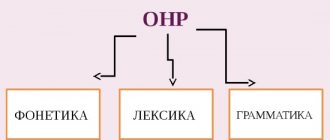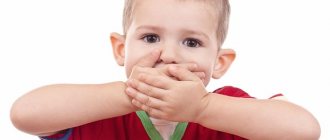General speech underdevelopment is divided into 4 levels, depending on the degree of severity. Type 1 OSD is the most severe degree of the disorder, in which a child 3 years of age or older is completely speechless. Either he pronounces only individual sounds or syllables, and does not use common speech.
If you do not begin to correct the disorder, it will lead to complications and have a negative impact on personal development, social and psycho-emotional spheres. Neurologists and speech pathologists-defectologists are involved in the diagnosis and correction of general speech underdevelopment of level 1. In this article we will talk about OHP: what it is, characteristics of 1 OHP, diagnosis, prevention and prognosis.
ONR: what is this?
You can suspect a general speech underdevelopment in a child if he said his first words late - by the age of 3 or even later; does not fulfill requests and exhibits low speech activity, does not try to verbally express his desires, and has neurological problems.
In children, not only the process of speech development as a whole is disrupted, but also the sequence and timing of mastering speech skills. In addition, they lag behind the age norm in other criteria, such as mental development.
OHP 1: characteristic of the violation
General underdevelopment of level 1 speech in a young child is characterized by the following signs:
- unformed phrasal speech;
- poor vocabulary;
- reducing sentences to one word;
- misunderstanding of the meanings of words, situational understanding of speech;
- features of articulation: it is incorrect, unclear, the baby pronounces sounds incorrectly or they are completely inaccessible to him;
- rearranging syllables, reducing words to 1 - 2 syllables;
- phonemic analysis of words is not available;
- the use of babble, gestures, facial expressions, amorphous words, and onomatopoeia in communication. Moreover, facial expressions are always applied to the location.
Thus, you don’t even need to be a doctor to understand that the baby has problems.
Level 1 ONR forms
There are 4 clinical forms of general speech underdevelopment of level 1. These include childhood aphasia, alalia, rhinolalia and dysarthria.
Childhood aphasia is an extremely rare disease, occurring in only 1% of children. They do not perceive and recognize speech poorly, do not master phrasal speech, and have difficulty establishing contact with other people. Childhood aphasia is very difficult to recognize in the early stages, so it is usually diagnosed late.
Alalia is underdevelopment of speech or its absence with intact hearing and intelligence. There are sensory and motor alalia. Children with motor alalia can begin to speak by the age of 4, they have poor coordination and fine motor skills, they replace some words with others, cannot express their thoughts, they have no desire to speak, they are touchy. With sensory alalia, children perceive speech incorrectly, repeat words after others, combine two words into one, and they often lack a connection between an object and the word denoting it. Such children can be withdrawn or, conversely, impulsive and very active.
Rhinolalia is manifested by incorrect sound pronunciation and changes in voice timbre. Rhinolalia is associated with impaired velopharyngeal closure.
Dysarthria is difficulty or distorted pronunciation of sounds and words. Associated with impaired innervation and limited mobility of the speech apparatus against the background of damage to the central nervous system.
As children with level 1 ODD say
Children with this diagnosis cannot use verbal means of communication - at all or partially.
Here are examples of level 1 OHP:
- they babble and make sounds: “dada” - “give”, “may” - “meow”;
- they speak only the root part of the word: “ku” - “doll”, “gu” - “toy”;
- denote several objects in one word: “ba” - “banana” and “apple”;
- denote in one word both objects and actions: “bibi” - any transport and “go”, “oko” - open and close a window;
- the same words are pronounced differently each time: “bus” - “abas”, “bass” “pencils” - “adshi”, “udas”;
- they shorten complex words: “the dog is sitting” - “paka di”, “we were walking on a hill” - “goka gi”.
Often such children do not understand the instructions of the speech therapist - they do not have enough vocabulary for this.
Pathogenesis
General speech underdevelopment develops in children against the background of other primary defects. This is aphasia, alalia, when a child’s active speech and its understanding are grossly upset. In other cases, OHP develops due to anatomical defects of the speech apparatus - rhinolalia, dysarthria. With such defects, sound pronunciation, syllabic composition, vocabulary and grammar of speech disintegrate.
According to researchers, preschoolers with ODD lag behind their peers not only in speech indicators, but also intellectually and physically. This is due to the timing of speech maturation, the ability to learn new things, and socialize.
Causes of 1st degree OHP
Various factors can lead to speech impairment. They can be divided into several groups:
- Intrauterine development. Bad habits of the mother, severe toxicosis, use of drugs prohibited during pregnancy, alcohol or drugs, asphyxia or hypoxia of the fetus, severe traumatic birth - as a result of these factors, the central nervous system of the newborn is damaged, which means there is a high risk of neurological problems, including speech disorders;
- The baby's health status. Frequent hospitalization, illness in the first years of life, traumatic brain injuries, neuroinfections, chronic diseases - all this affects his mental development, including further speech acquisition;
- Social factors. Negative, emotionally tense family environment, pedagogical neglect, indifferent or cruel treatment of the child, emotional shocks and traumas, affects, as well as ignorance of delayed speech development, which can subsequently turn into underdevelopment.
The prenatal period and the first year of life play a huge role in the mental development of children.
Comprehensive diagnosis of the disease
The examination involves a pediatrician, neurologist, otolaryngologist, speech pathologist, and psychiatrist.
The pediatrician assesses the general health of the little patient and provides referrals for consultations with specialized specialists.
The otolaryngologist evaluates hearing acuity and excludes deafness.
A psychiatrist assesses the mental health of a small patient and excludes diseases according to his profile, which may also be accompanied by impaired speech development. This includes, for example, autism.
But the leading role is assigned to the neurologist and speech therapist. It is these specialists who diagnose the disease, assess its severity, identify the cause and develop a treatment regimen.
A neurologist assesses the patient’s neurological status, prescribes hardware diagnostics (for example, MRI of the brain), determines the cause of speech disorders and makes recommendations to a speech therapist. For type 1 OHP, the neurologist usually prescribes drug therapy, physiotherapy, and massage.
Speech therapy correction
A speech pathologist-defectologist determines the child’s speech status. First, he collects an anamnesis - from the opinions of other specialists and information provided by the parents. He asks the parents how the pregnancy proceeded, when the baby began to show speech activity (for example, began to coo), when he said the first word, how much he generally strives to communicate - all this is very important.
Then the speech therapist studies the child’s speech apparatus and examines the components of the language: features of sound pronunciation, the little patient’s ability to compose a meaningful, coherent and literate text, and the volume of vocabulary.
Based on the data obtained, the specialist makes a final diagnosis: the form and degree of speech development disorder, and also prescribes a correction program.
Since in group 1 OHP all parts of the language system are severely underdeveloped, the child does not speak common speech, a speech therapist teaches him to understand speech addressed to him, increases speech activity, and activates speech imitation.
Additionally, the small patient is prescribed speech therapy massage (normalizes speech muscles to make it easier for him to pronounce sounds), microcurrent treatment (activates the speech centers of the brain) and drug therapy. All these procedures are prescribed by a neurologist.
The correction of grade 1 OHP is approached in a comprehensive manner. It is impossible to achieve results on your own at home, so the child must systematically study with a speech therapist-defectologist. Exercising at home with your parents is also important - a specialist will give you a set of exercises. All exercises are performed in the form of a game. As a rule, children with grade 1 ODD are trained individually, although sometimes classes are conducted in groups of 2–3 people.
Only this approach will help the child move to a higher level of speech development and master new skills.
Complications of type 1 OHP
Neurologists and speech therapists say that up to the age of 3, children can speak the way they want and the way they can. Each baby has its own pace of development, so your son or daughter may not “fit” into the age range. But if a child is 3 years old and has only said his first word, this may already indicate a delay in speech development.
If, at the age of 5, he speaks at the level of a two-year-old (slowly, not in sentences, incoherently), his speech is illiterate and incomprehensible, then it is worth urgently showing him to a neurologist or speech therapist. Even if your child understands speech addressed to him and fulfills requests, do not expect him to speak out on his own. You can only waste time. Namely, it plays a decisive role in the correction of the first level of OHP.
If you ignore the problem, it will progress quickly. And this goes beyond just speech: against the backdrop of worsening speech underdevelopment, the baby’s mental development is also disrupted. He cannot think productively, does not remember well, his physical development, coordination of movements, and fine motor skills suffer.
Further - worse. Personal changes also occur: the child becomes withdrawn, does not want to communicate with peers and parents, becomes indifferent to everything, self-esteem decreases, and behavioral disorders begin.
Children with speech underdevelopment cannot master the curriculum of a regular school, so they are sent to special schools.
As a result, mental retardation is formed against the background of a general speech disorder.
Prognosis and prevention of disorders
The prognosis depends on various factors - the cause and form of the disorder, the timeliness of the correction started, and the regularity of classes. Such children have fully intact compensatory capabilities, so they quickly respond to corrective measures. The earlier treatment begins, the better results can be achieved. If the child is 3 years old, this is the best time to start correction - by the age of 5 - 7 years, you can bring his speech closer to normal or completely eliminate the problem. If you ignore the disease, it will only progress.
No one is immune from speech pathologies. Therefore, for the purpose of prevention, it is better to show a child aged 2.5 to 3 years to a speech therapist. The specialist will assess the speech status of the little patient. And if it reveals a discrepancy with age standards, it will immediately begin correction.
Family also plays a huge role. A friendly atmosphere in the home and a warm attitude are the foundations for the normal development of any child. Parents should engage with their daughter or son: talk to him, tell him, explain, play, communicate, engage him in dialogue - all this activates speech activity.
Comparative features of speech development disorders
The characteristics of the pathology identified in a child depend on the severity of symptoms:
| Vocabulary | Sound pronunciation | Phonemic awareness/phonemic hearing | Grammatical structure | Syllable structure | Connected speech | Understanding | |
| OHP level 1 | Onomatopoeia, babbling words | Multiple violations | In pristine condition/ grossly damaged | Violated | Violated | Absent | Depends on the situation |
| OHP level 2 | Small (much smaller than normal) | Various and varied distortions, substitutions, lack of sounds | Failure | Not formed | Grossly violated | Phrase of 2-3 words | Develops significantly |
| OHP level 3 | Significantly increases | All types of sound disturbances occur | Insufficiently developed / skills of sound analysis and synthesis are not formed independently | Correct use of simple sentences, specific errors (incorrect agreement, omission and replacement of prepositions, errors in stress) | The syllable structure is less disrupted, but errors remain (syllable shortening, rearrangement, substitution) | Predominance of simple sentences | Already closer to normal |
| OHP level 4 | Practically the norm | There may be distortion of sounds, difficulties in staging [P] | Insufficiently formed | There may be errors in the use of nouns, case endings (genitive and accusative), plurals, and the use of complex prepositions | Some violations remain - abbreviation, rearrangement of sounds, much less often - omission and rearrangement of syllables, addition of syllables | Omission and replacement of conjunctions, inversions (rearrangement of the usual word order in a sentence) | Practically the norm |
As can be seen from the table, each level has its own characteristic features and the first is the most difficult.






